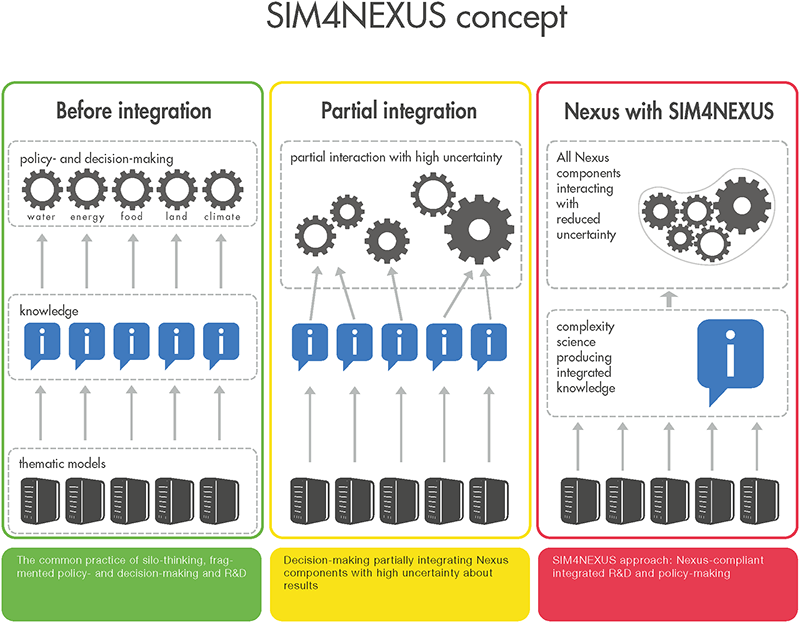Our Work
SIM4NEXUS has a strong research dimension. SIM4NEXUS advanced in the understanding and assessment of the Nexus in various con- texts. A framework for the assessment of the Nexus is developed to facilitate future research assessing the impacts of interventions from
a Nexus perspective. Moreover, interlinkages between water, land, food, energy and climate are now made operational, identifying both the most influential and vulnerable resources. The degrees of interlinkages are defined, including direct and indirect pathways from one Nexus component to another. The Greek case study for example, proves the food sector is the one with the most influence on other Nexus dimen- sions, while water is the most affected and vulnerable resource (Laspidou et al., 2019).
Agriculture and Food are key sectors to increase the sustainability of natural resource use.
Climate change, climate change mitigation, and adaptation put pressure on agriculture and food security. At the same time, the agro-food chain can offer solutions for these problems, for example, by replacing animal with vegetable proteins in the diet and increasing resource efficiency in the agro-food chain.
European Common Agricultural Policy can support the transition to more resource-efficient agriculture, e.g., by encouraging farmers to grow less water-demanding or non-irrigated crops, to use technologies for precision irrigation and to reduce emissions of nutrients and pesticides. To protect and restore the soil, water, biodiversity, ecosystems and the landscape, Good Agricultural and Environmental Conditions (GAEC) and Greening measures should be stricter and better maintained, and direct payment should be linked to public services instead of agricultural land area.
Successful Nexus policy has many dimensions and is multi-scale. It concerns the whole policy cycle and depends on political will, mindset, a common vision, knowledge management and careful organisation of the process, which is complex and uncertain. Pilots and scenario analyses are helpful, and monitoring of progress and results is vital, as well as collaboration between researchers, stakeholders and policymakers from the start to end of the process. Long-term engagement and financing must be part of the deal, as no sector or sectoral institution feels responsible for the Nexus between sectors. Thematic approaches stimulate a Nexus approach, such as the European ‘From Farm to Fork’ and ‘Circular Economy’ initiatives.
The following policy briefs have been published:
• Coherence in EU policy on water, land, energy, food and climate: Climate change adaptation policies (2017)
• Policy coherence of the EU Common Agricultural Policy (CAP) within the Nexus between water, energy, land, food and climate depends on policy implementation (2019)
• Implementation of EU Water Policies may benefit from synergies within the nexus between water, energy, land, food and climate (2019)
• Eight Policy Coherence Recommendation to the European Green Deal (2020)
• Landscape restoration to mitigate and adapt to climate change in Central and Eastern Europe (2020)
System Dynamics Modelling (SDM) is our methodology of integration, including the modelling of multiple feedback and interaction among resources in the Nexus. SDM dates back from the 1960s. Used for studying feedback problems in industrial processes, it aims to understand how a system behaves and responds to incentives and changes. It proved to be a strong innovative methodology to test the Nexus concept.
The project builds on well known and scientifically established existing models, each to simulate different themes of the Nexus, such as Capri. E3ME, IMAGE-GLOBIO, MAGNET, MagPIE, OSeMOSYS and SWIM.
System Dynamics Modelling is used, integrating public domain data and metadata for decision and policy making.
SIM4NEXUS has developed a Serious Game. The Serious Game is a computer game that aids learning about the Nexus by helping users to understand and explore the interactions between water, energy, land and food resources management under a climate change context, divides the problem into manageable interventions, and allows participants to learn by doing. The ultimate goal of game development is to create a fun and interactive capacity-building tool to be used in research, educational settings and management.
The SIM4NEXUS Serious Game provides impressive user experience and state of the art technology to allow users to learn about the Nexus concepts while playing. To that end, the game relies on four main elements: the Graphic User Interface, the Knowledge Elicitation Engine, the Game Logic and the Nexus repositories.
Click here for more information
Methodologies and tools to integrate the Nexus components have been tested with real-life challenges in 12 case studies at regional, national, European and global scales. The SIM4NEXUS Partners worked in close collaboration with relevant stakeholders to (a) specify the Nexus challenges they face; (b) apply the tools developed by SIM4NEXUS; (c) investigate the applicability and relevance of these tools for supporting decisions and raising awareness; (d) develop effective policy adaptation and implementation that supports a resource-efficient Europe. The science-policy participatory and iterative process established has successfully led to policy recommendations.
An amazing wealth of data has been collected, both from local sources and thematic models, and connected through the specific System Dynamic Models. Policy interventions have been tested through the Serious Game and best possible combinations towards Nexus-compliance have been identified.
An extensive market study was carried out to determine the potential customers and competitors of the SIM4NEXUS Serious Game. Different types of actors were approached (public, private, public authorities, associations, NGOs). The aim was to determine the needs of end-users in terms of Serious Game use.
Exploitation strategy and business models were agreed to enable collaborations after the project end. This includes a 2-year trial and commercialisation plans for a start-up creation, including customer training at several levels.
Test-playing of the Serious Game at “customer feedback workshops” to enable product improvement.
Click here for more information
